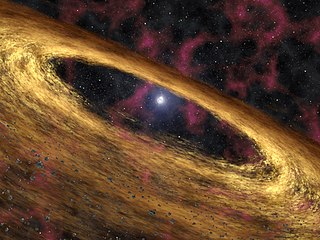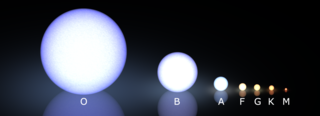
The photosphere is a star's outer shell from which light is radiated. The term itself is derived from Ancient Greek roots, φῶς, φωτός/phos, photos meaning "light" and σφαῖρα/sphaira meaning "sphere", in reference to it being a spherical surface that is perceived to emit light. It extends into a star's surface until the plasma becomes opaque, equivalent to an optical depth of approximately 2/3, or equivalently, a depth from which 50% of light will escape without being scattered. In other words, a photosphere is the deepest region of a luminous object, usually a star, that is transparent to photons of certain wavelengths.

In astronomy, a blue giant is a hot star with a luminosity class of III (giant) or II. In the standard Hertzsprung–Russell diagram, these stars lie above and to the right of the main sequence.

Blue supergiant stars are hot luminous stars, referred to scientifically as OB supergiants. They have luminosity class I and spectral class B9 or earlier.

In astronomy, metallicity is used to describe the abundance of elements present in an object that are heavier than hydrogen or helium. Most of the physical matter in the Universe is in the form of hydrogen and helium, so astronomers use the word "metals" as a convenient short term for "all elements except hydrogen and helium". This usage is distinct from the usual physical definition of a solid metal. For example, stars and nebulae with relatively high abundances of carbon, nitrogen, oxygen, and neon are called "metal-rich" in astrophysical terms, even though those elements are non-metals in chemistry.
Erick Francisco Casas Ruiz is a Mexican professional wrestler currently working under the ring name Heavy Metal for AAA. He is the son of referee Pepe Casas and part of the Casas wrestling family; the brother of Negro Casas and Felino.

4U 0142+61 is a magnetar at an approximate distance of 13000 light-years from Earth, located in the constellation Cassiopeia.

Mu Cassiopeiae is a binary star system in the constellation Cassiopeia. This system shares the name Marfak with Theta Cassiopeiae, and the name was from Al Marfik or Al Mirfaq (المرفق), meaning "the elbow".
2MASS 0532+8246 is possibly the first brown dwarf observed in the galactic halo of the Milky Way, and the first known substellar subdwarf star. It was discovered from Two Micron All-Sky Survey data, and verified by observations at Palomar Observatory and W. M. Keck Observatory. It has a low metallicity, which indicates it is an old star. With an age of 12.5 billion years, it is the oldest known brown dwarf star.
GD 362 is a white dwarf approximately 150 light years from Earth. In 2004, spectroscopic observations showed that it had a relatively high concentration of metals in its atmosphere. Since the high gravitational field of white dwarfs quickly forces heavy elements to settle towards the bottom of the atmosphere, this meant that the atmosphere was being polluted by an external source. In 2005, infrared photometric observations suggested that it was surrounded by a ring of dust with size comparable to the rings of Saturn, providing an explanation for this pollution.
V391 Pegasi, also catalogued as HS 2201+2610, is a blue-white subdwarf star approximately 4,570 light-years away in the constellation of Pegasus. The star is classified as an "extreme horizontal branch star". It is small, with only half the mass and a bit less than one-quarter the diameter of the Sun. It has luminosity 15.4 times the Sun. It could be quite old, perhaps in excess of 10 Gyr. It is a pulsating variable star of the V361 Hydrae type.

A B-type subdwarf (sdB) is a kind of subdwarf star with spectral type B. They differ from the typical subdwarf by being much hotter and brighter. They are situated at the "extreme horizontal branch" of the Hertzsprung–Russell diagram. Masses of these stars are around 0.5 solar masses, and they contain only about 1% hydrogen, with the rest being helium. Their radius is from 0.15 to 0.25 solar radii, and their temperature is from 20,000 to 40,000K.

A subdwarf O star (sdO) is a type of hot, but low-mass star. O-type subdwarfs are much dimmer than regular O-type main-sequence stars, but with a brightness about 10 to 100 times that of the Sun, and have a mass approximately half that of the Sun. Their temperature ranges from 40,000 to 100,000 K. Ionized helium is prominent in their spectra. Gravity acceleration is expressed by log g between 4.0 and 6.5. Many sdO stars are moving at high velocity through the Milky Way and are found at high galactic latitudes.
The blanketing effect is the enhancement of the red or infrared regions of a stellar spectrum at the expense of the other regions, with an overall diminishing effect on the whole spectrum. The term originates in a 1928 article by astrophysicist Edward Arthur Milne, where it was used to describe the effects that the astronomical metals in a star's outer regions had on that star's spectrum. The name arose because the absorption lines act as a "blanket", causing the continuum temperature of the spectrum to rise over what it would have been if these lines were not present.
Gliese 1062 is a M-type subdwarf star in the constellation Eridanus. The star has a total proper motion of 3.033 "/yr, making it the 25th-fastest-moving star in terms of angular position as seen from Earth, and its radial velocity is -18 km/s. At a distance of about 52 light years and with an absolute magnitude of 13.1, this star has an apparent magnitude of 14.6 when viewed from Earth.

Omega Orionis is a star in the constellation Orion. Its apparent magnitude is 4.57 and is located approximately 1,400 light years from our solar system. It is surrounded by a cloud of dust, forming a modest reflection nebula over a light-year wide.

An O-type star is a hot, blue-white star of spectral type O in the Yerkes classification system employed by astronomers. They have temperatures in excess of 30,000 kelvins (K). Stars of this type have strong absorption lines of ionised helium, strong lines of other ionised elements, and hydrogen and neutral helium lines weaker than spectral type B.
The heavy metal subdwarfs are a type of hot subdwarf star with high concentrations of heavy metals. The metals detected include germanium, strontium, yttrium, zirconium and lead. Known heavy metal subdwarfs include HE 2359-2844, LS IV-14 116, and HE 1256-2738.
LS IV-14 116 is a hot subdwarf located approximately 2,000 light years away on the border between the constellations Capricornus and Aquarius. It has a surface temperature of approximately 34,000 ± 500 kelvins. Along with stars HE 2359-2844 and HE 1256-2738, LS IV-14 116 forms a new group of star called heavy metal subdwarfs. These are thought to be stars contracting to the extended horizontal branch after a helium flash and ejection of their atmospheres at the tip of the red giant branch.









